Dr. Frank K. Tittel, Rice University
Commercial and research QCL sources can target strong fundamental rotational-vibrational gas absorption lines in the mid-IR spectral range and pure rotational lines in the terahertz range that are one to two orders of magnitude stronger than overtone transitions in the NIR.
Detecting and monitoring trace-gas molecules in real-world applications – atmospheric chemistry, pollution monitoring, medical diagnostics, industrial process control, defense and more – require the targeting of fundamental rotational-vibrational molecular absorption bands between 3 and 24 µm. This spectral region can be accessed by commercially available narrow-linewidth and high-performance semiconductor lasers, particularly quantum cascade lasers (QCLs) and interband cascade lasers (ICLs) from 3 to 12 µm, as depicted in Figure 1.
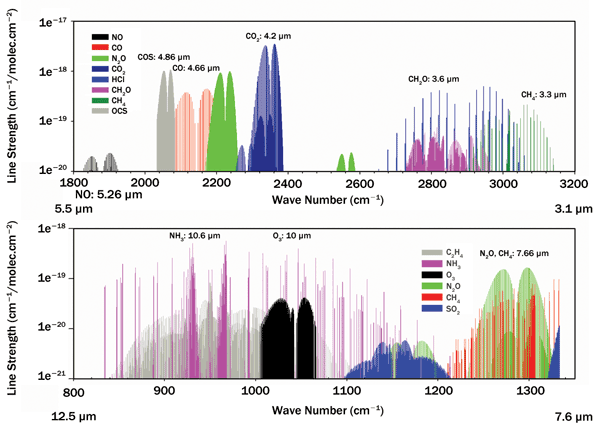
Figure 1. HITRAN simulated mid-IR molecular absorption spectra from 3.1 to 12.5 µm.
Trace-gas optical spectroscopic sensors using QCLs or ICLs as an excitation source can achieve continuous, ultrasensitive detection of trace-gas molecular species at concentration levels from the percent level down to parts per trillion (ppt).1 The principle of molecular absorption is based on the transitions that an electromagnetic wave causes in a chemical species. If the molecule is irradiated with IR light, the electron is excited to a manifold consisting of rotational-vibrational energy level. These absorption lines are specific for each chemical species. During the past decade, several sensor technologies have been developed, including: laser-absorption spectroscopy based on a multipass gas absorption cell, cavity-enhanced and cavity ringdown spectroscopy, photoacoustic and quartz-enhanced photoacoustic spectroscopy, Faraday rotation spectroscopy limited to parametric chemical species; differential optical dispersion spectroscopy and noise-immune cavity-enhanced optical heterodyne molecular spectroscopy, and frequency comb spectroscopy.
Photoacoustic spectroscopy
One of the most robust and sensitive trace-gas optical detection techniques is photoacoustic spectroscopy (PAS), which is capable of extremely high detection sensitivities with a compact and relatively low-cost absorption detection module.2 This technique is also based on an optical absorption process but differs from laser-absorption spectroscopy in the physical phenomenon used for the detection of the absorption signal. When light at a specific wavelength is absorbed by the gas sample, the excited molecules will subsequently relax to the ground state by means of nonradiative processes. These processes produce localized heating in the gas, which in turn results in an increase of local pressure. If the incident-light intensity is modulated, the generation of thermal energy in the sample will also be periodic, and a pressure wave will be produced with the same frequency of the light modulation. The PAS signal can be amplified by tuning the modulation frequency to one of the acoustic resonances of the gas sample cell. The key advantages of this technique are that no optical detector is required and that the resulting sound waves can be detected by a commercial hearing aid microphone.
Quartz-enhanced photoacoustic spectroscopy
Quartz-enhanced photoacoustic spectroscopy (QEPAS) is an alternative approach to photoacoustic detection of trace gas, using a quartz tuning fork (QTF), as shown in Figure 2a, as a sharply resonant acoustic transducer to detect weak photoacoustic excitation in extremely small volumes.3 A quartz crystal is a natural candidate for such an application because it is a low-loss, low-cost piezoelectric material. QTFs are employed as a frequency standard in watches and smartphones with a resonant frequency of 215 or ~32,768 Hz. These QTFs have a Q ≈ 100,000 when enclosed in vacuum and a Q of ≈ 10,000 at normal atmospheric pressures. Acoustically, the QTF is a quadrupole, which provides good environmental noise immunity. In fact, the width of the QTF resonance at normal pressure is ~4 Hz, so that only frequency components in this narrow spectral band can produce efficient excitation of the QTF vibrations.
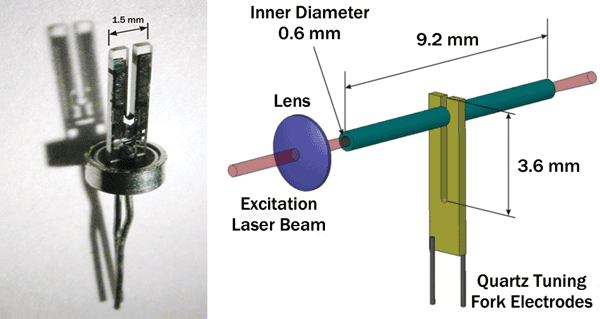
Figure 2. (a) Quartz tuning fork as a resonant microphone for QEPAS: extremely low internal losses; Q ~10,000 at 1 atm; large dynamic range (~106); low sensitivity to external sound; and wide temperature range from 1.6 to ~700 K. (b) Acoustic microresonator enhancement of QEPAS signal-to-noise ratio is ~30 (depending on gas composition and pressure). Optimum parameters such as inner diameter and length are indicated. The mR-QTF gap is 25 to 50 µm.
Resonant properties and noise of QTFs
QTFs can be designed to resonate at any frequency in the 4- to 200-kHz range and beyond, since resonance frequencies are defined by the properties of the piezoelectric material and its geometry. The interaction between the laser-modulated beam and a trace gas leads to the generation of acoustic waves that mechanically bend the QTF prongs. Hence, the electrode pairs of the QTF will be electrically charged. An ultralow-transimpedance amplifier with a feedback resistor of 10 MΩ is used to acquire QTF electrical response.
QEPAS sensor
A sketch of a typical sensor used in most QEPAS systems reported to date is shown in Figure 3. The optical components may vary depending on the spectral range, target molecule and the type of distributed feedback (DFB) QCL or DFB ICL with an integrated Peltier cooler. Typically, the wavelength of the laser is varied by changing the driving current when the temperature of the excitation laser is fixed.
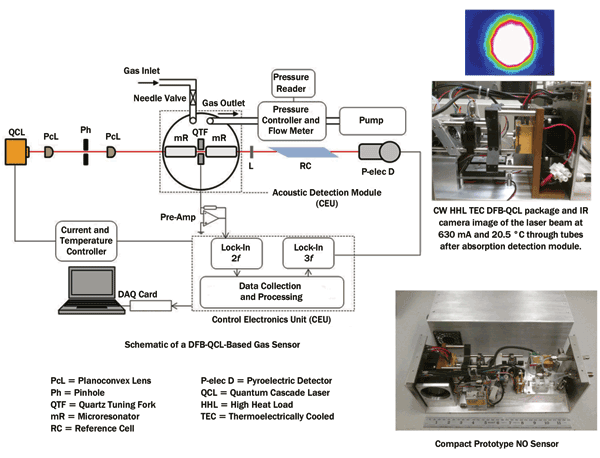
Figure 3. Schematic of a CW-TEC DFB QCL-based QEPAS NO gas sensor.
The main laser beam is focused between the two QTF prongs using an aspheric lens. Wavelength modulation is implemented by applying a sinusoidal dither to the laser current at half of the QTF resonance frequency. A control electronics unit acquires the demodulated QTF signal by means of a lock-in amplifier. The lock-in amplifier is usually controlled via a laptop computer through a National Instruments USB card or RS-232 interface. The transmitted laser excitation enters a small reference cell filled with a high concentration of the targeted trace gas. The light exiting the reference cell is detected by a photodetector and the absorption signal demodulated at 3f by means of a lock-in amplifier. In this way, a 3f wavelength-locking technique can be implemented to lock the laser wavelength to the absorption peak line of the targeted molecule.
A wavelength-modulation technique is commonly used to improve the QEPAS signal-to-noise ratio and to protect a QEPAS-based sensor system from external acoustic noise. The generated QEPAS signal is usually demodulated by means of a lock-in amplifier at the fundamental frequency f or at the successive harmonics.
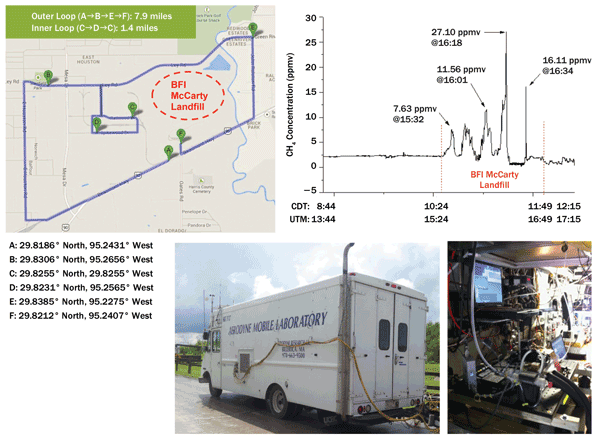
Figure 4. Methane perimeter measurements performed adjacent to the BFI McCarty Landfill waste site with a DFB QCL-based QEPAS sensor installed in the Aerodyne mobile laboratory4 (Sept. 10, 2013).
Minimum detection limits can be quantified as the noise-equivalent concentration (NEC), allowing different sensors to be compared without reference to the specific target gas. For estimates of noise and precision, we use the convention that the NEC is the gas target concentration giving a signal equal to the root- mean-squared value of signal intensity variations (1σ). For many sensor systems, white noise dominates and, therefore, the signal-to-noise ratio also depends on the measurement bandwidth. When operating in this domain, it is important to record the value of the measurement integration time t used to obtain the normalized noise-equivalent absorption coefficient (NNEA) measured in cm−1 W/Hz−1/2, by normalizing the noise-equivalent absorption to a 1-Hz measurement bandwidth.
Results
In Table 1, we provide the results obtained to date for QEPAS-based trace-gas sensors. For each gas target, we list the mid-IR wave number of the excitation laser, optimum pressure, available power and sensor performance in terms of the NNEA and NEC.
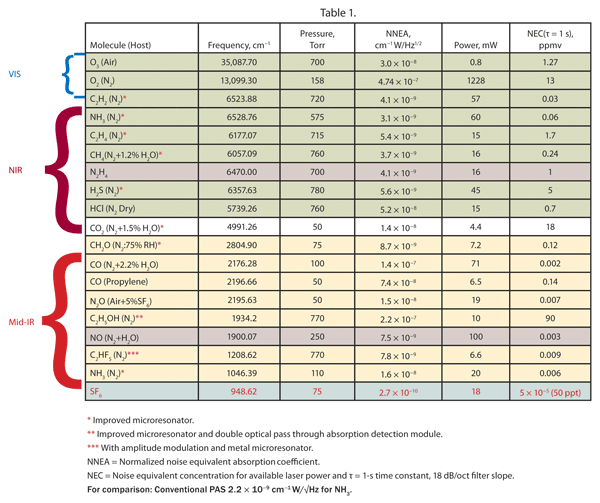
The best results in terms of minimum detectable gas concentration have been obtained by using acoustic microresonator tubes (Figure 2b) and positioning a commercial, low-cost 32.78-kHz QTF between the tubes to probe the acoustic vibration excited in the gas contained inside the tubes (on-beam configuration). This configuration increases the QEPAS sensitivity up to 30 times, compared with a QEPAS sensor with a bare QTF.
The recent development of long-wavelength quantum cascade lasers made it feasible to use the QEPAS technique in the terahertz range by employing a custom QTF with larger space between the two prongs to allow optimized terahertz beam focusing, thereby reaching a detection sensitivity level comparable to the best results reported in the mid-IR. Moreover, an innovative spectroscopic technique called I-QEPAS – a merging of cavity-enhanced spectroscopy and QEPAS methods – was recently demonstrated and may lead to the realization of sensors with a parts-per-quadrillion minimum detection limit and an NNEA in the 10−12 W cm−1/Hz−1/2 range.
Compact, sensitive and selective QEPAS sensors have been demonstrated to be effective and mature for numerous real-world applications. These now include environmental monitoring (CO, CO2, CH4, CH2O, C2HF5, N2O, NO2), industrial emission measurements such as at combustion sites and gas pipelines (HCl, CO2, CH4, CO, NOx, CH2O), urban emissions from automobile traffic (NOx, SOx), rural emission such as horticultural greenhouses and fruit storage (C2H6, C2H4, CH4, N2O), control for manufacturing processes (SF6, HCl), detection of medically important molecules (NO, CO, NH3, C2H6, H2S, H2O2) and toxic gases (CH2O, HCl, HCN, N2H4).4
For example, a QEPAS-based sensor was installed in a mobile laboratory to perform atmospheric CH4 and N2O detection near two urban landfill sites located in Houston.5 The QEPAS sensor recorded concentration values in very good agreement (<5% difference) with those measured by Aerodyne Research Inc.’s QCL mini monitor multipass optical sensor with a CH4-detection sensitivity of 300 ppt and N2O-detection sensitivity of 60 ppt, both in 1 second – which demonstrates the precision, stability and applicability
of the QEPAS sensing technique.
Meet the author
Dr. Frank Tittel, a J.S. Abercrombie Professor in the Electrical and Computer Engineering Department at Rice University in Houston, has been associated with the Princeton University-led MIRTHE since 2006; email: [email protected].
Acknowledgments
The author expresses gratitude to both current and past members of the Rice University Laser Science Group (LSG) as well as visiting scholars. The Rice LSG acknowledges financial support from an NSF ERC MIRTHE award and an NSF-ANR award for international collaboration in chemistry, “Next generation of Compact Infrared Laser based Sensor for Environmental monitoring (NexCILAS).”
References
1. R. Lewicki et al (2013). Current status of mid-infrared semiconductor-laser-based sensor technologies for trace-gas sensing applications. In: M. Razeghi, L. Esaki and K. von Klitzing (Eds.), The Wonder of Nanotechnology: Present and Future of Optoelectronics Quantum Devices and Their Applications (pp. 597-632). SPIE Press.
2. F.K. Tittel et al (2013). Tunable mid-infrared laser absorption spectroscopy. In: A. Baranov and E. Tournie (Eds.), Semiconductor Lasers: Fundamentals and Applications (pp. 579-629). Cambridge, England: Woodhead Publishing Ltd.
3. F.K. Tittel et al (2013). Emerging infrared laser absorption spectroscopic techniques for gas analysis. In: W.M. Geiger and M.W. Raynor (Eds.), Laser Absorption Spectroscopic Techniques (pp. 71-109). New York: John Wiley & Sons Inc.
4. W. Ren et al (Jan. 27, 2014). Hydrogen peroxide detection with quartz-enhanced photoacoustic spectroscopy using a distributed-feedback quantum cascade laser. Appl Phys Lett, Vol. 104, 041117.
5. M. Jahjah et al (Feb. 15, 2014). Atmospheric CH4 and N2O measurements near Greater Houston area landfills using QCL-based QEPAS sensor system during DISCOVER-AQ 2013. Opt Lett, Vol. 39, pp. 957-960.